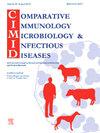将布氏杆菌解毒脂多糖和水解o -多糖与破伤风类毒素联合或结合免疫BALB/c小鼠,可增强对病原体的保护性免疫反应
IF 2
3区 农林科学
Q4 IMMUNOLOGY
Comparative Immunology Microbiology and Infectious Diseases
Pub Date : 2025-05-10
DOI:10.1016/j.cimid.2025.102357
引用次数: 0
摘要
脂多糖(LPS)是布鲁氏菌的主要表面抗原,布鲁氏菌是一种引起动物和人类布鲁氏菌病的细胞内病原体。对这一关键抗原引起的免疫反应的更深入了解可能为开发用于人类和动物的有效疫苗提供有价值的见解。本研究制备了B. melitensis的解毒LPS (d-LPS)和水解o -多糖(OPS),分别与破伤风类毒素(TT)结合作为载体蛋白。将得到的偶联物d-LPS-TT和OPS-TT,以及d-LPS+TT和OPS+TT的混合物分别免疫各组BALB/c小鼠。结合抗原可诱导针对多糖成分的igg2a特异性血清反应。此外,用d-LPS-TT和OPS-TT免疫的小鼠在腹腔内注射B. melitensis 16 M后,IL-12和IFN-γ水平升高。值得注意的是,在接受d-LPS-TT的小鼠中观察到最强的保护性免疫反应。大多数先前的研究将保护性反应主要归因于特异性血清抗体。虽然针对布鲁氏菌多糖的抗体通常与t -辅助性2 (Th2)型反应相关,在感染过程中产生,但它们不足以从宿主中消除细胞内病原体。虽然确切的机制仍有待完全阐明,但我们的研究结果表明,用共价结合的多糖抗原免疫可能促进t -辅助性1(Th1)型细胞免疫,这似乎在保护猪B. melitensis中起着更关键的作用。本文章由计算机程序翻译,如有差异,请以英文原文为准。
Immunization of BALB/c mice with detoxified lipopolysaccharide and hydrolytic O-polysaccharide from Brucella melitensis either in combination with or conjugated to tetanus toxoid, enhances protective immune responses against the pathogen
Lipopolysaccharide (LPS) is the major surface antigen of Brucella, an intracellular pathogen that causes brucellosis in both animals and humans. A deeper understanding of the immune responses elicited by this key antigen may offer valuable insights for the development of effective vaccines for use in both humans and animals. In this study, detoxified LPS (d-LPS) and hydrolytic O-polysaccharide (OPS) from B. melitensis were prepared and separately conjugated to tetanus toxoid (TT) as a carrier protein. The resulting conjugates, d-LPS-TT and OPS-TT, as well as mixture of d-LPS+TT and OPS+TT, were used to immunize separate groups of BALB/c mice. The conjugated antigens induced significant IgG2a-specific serum responses targeting the polysaccharide components. Furthermore, mice immunized with d-LPS-TT and OPS-TT demonstrated elevated levels of IL-12 and IFN-γ following intraperitoneal challenge with B. melitensis 16 M. Notably, the strongest protective immune responses were observed in mice receiving the d-LPS-TT. Most previous studies have attributed protective responses primarily to specific serum antibodies. Although antibodies against Brucella polysaccharides typically associated with T-helper 2 (Th2) type responses, develop during infection, they are insufficient to eliminate the intracellular pathogen from the host. While the precise mechanism remain to be fully elucidated, our findings suggest that immunization with covalently conjugated polysaccharide antigens may promote T-helper 1(Th1) type cellular immunity, which appear to play a more pivotal role in protection against B. melitensis.
求助全文
通过发布文献求助,成功后即可免费获取论文全文。
去求助
来源期刊
CiteScore
4.60
自引率
0.00%
发文量
102
审稿时长
40 days
期刊介绍:
Comparative Immunology, Microbiology & Infectious Diseases aims to respond to the concept of "One Medicine" and to provide a venue for scientific exchange. Based on the concept of "Comparative Medicine" interdisciplinary cooperation between specialists in human and animal medicine is of mutual interest and benefit. Therefore, there is need to combine the respective interest of physicians, veterinarians and other health professionals for comparative studies relevant to either human or animal medicine .
The journal is open to subjects of common interest related to the immunology, immunopathology, microbiology, parasitology and epidemiology of human and animal infectious diseases, especially zoonotic infections, and animal models of human infectious diseases. The role of environmental factors in disease emergence is emphasized. CIMID is mainly focusing on applied veterinary and human medicine rather than on fundamental experimental research.

 求助内容:
求助内容: 应助结果提醒方式:
应助结果提醒方式:


